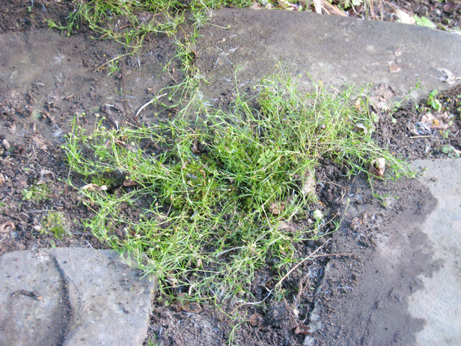
|
| Pearlwort; Sagina procumbens L. |
Pink Family; CARYOPHYLLACEÆ
|
| Pearlwort is no noble savage. It is a dwarf pest: a mossy, bright rich green annual, biennial or perennial herb. Native in boreal
Northeast America, Greenland, Europe and Asia; now it's a widespread weed. Botanists don't classify it with mosses; close examination reveals
it is a dwarf seed-producing plant: it actually has tiny whitish "bird's-eye" flowers April through November. To scientists, mosses have
a particular biology of absolutely no flowers, and reproduction by microscopic wind-borne spores rather than by seeds. However, for
all practical purposes this underfoot weed may be considered a moss. |
| It prefers to grow on moist soil, whether rich or poor in nutrients. Unlike many mosses, it is not found on tree trunks, boulders,
rotting logs, roofs, concrete walls, etc. And it can't stand the heavy shade in which some mosses thrive. |
| Most gardeners hate it, for it has a way of becoming a thick, permanent groundcover. It spreads through a garden the same way
cigarette smoke fills a room. That smoke is poisonous does not necessarily make it unpleasant to many persons; and that Pearlwort is an
opportunistic, persistent weed neither makes it an ecologic screw-up nor an Agent of Satan despised by all. The one place where it really
must be excluded is in alpine or rock gardens, where it can pick on prized plants its own size and outcompete them. Many ordinary gardeners tolerate it,
and some even encourage it. Nurseries sell related species as Scotch or Irish Moss. In the Seattle Tilth weed patch, over
61/2 years old, Pearlwort has proven one of the most consistently attractive and least troublesome inhabitants. |
Were it fragrant as Creeping Thyme or Corsican Mint, or with pretty flowers like Moss Campion, it would be grown in gardens
despite its weedy tendency. After all, we cultivate some plants every bit as weedy: such as the common Forget-Me-Not
(Myosotis sylvatica). But Pearlwort lacks floral beauty, fragrance, medicinal, dye, fiber or edible utility, and so has nothing to recommend it, except its flattish,
bright mossy habit. And the gardener incapable of improving on such a mere cushion of soft verdure is a rare one.
|
Originally published as the Seattle Tilth newsletter Weed of the Month in January 1988, along with an illustration from a book.
Back |
|
|

